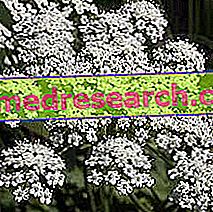
Scientific name
Pimpinella anisum L.
Family
UmbelliferaeOrigin
Europe
Synonyms
Green anise or common anise
Used Parts
Drug consisting of dried fruits (improperly called seeds) of anise
Chemical constituents
- Essential oil, rich in anethole (70-90%);
- Cumarine and Furocumarine;
- Flavonoids;
- triterpenes;
- Caffeic acid derivatives;
- Fatty oils;
- Protein substances.
Anise in Herbalist: Properties of Anise
The phytotherapeutic properties of anise relate to its use as a digestive, carminative, stimulating exocrine glands, galactogogues and balsamic.
Expectorant and anti-inflammatory properties for the respiratory tract are also described, as are galactogogues (folk medicine).
Anise exhibits mild sedative properties, useful in the presence of insomnia and nervous excitement.
For external use, the anise extracts are used as flavoring in deodorant, mouthwash and toothpaste products.
Biological activity
As mentioned, different properties are attributed to anise, among which we mention the stomachic, carminative, spasmolytic, cholagogic, expectorant and antiseptic ones.
More in detail, these activities are mainly ascribed to the essential oil of anise, whose main component is anethole.
Studies conducted on animals, in fact, have shown that anise oil is able to exert a spasmolytic and expectorant action; in addition to possessing antibacterial, antiviral and insect repellent properties. For this reason, the use of the plant has been approved for the treatment of various types of respiratory tract diseases.
As for the other activities ascribed to the plant, instead, at the moment, there are no recent studies able to confirm them. However, in light of the empirical data available so far, anise is still considered an excellent remedy capable of promoting digestion and able to promote salivary and biliary secretions.
Anise against diseases of the respiratory tract
Thanks to the expectorant, balsamic, antibacterial and antiviral properties of anise essential oil, its use constitutes a valid remedy for the treatment of different types of airway diseases, such as coughs, bronchitis and catarrhal diseases in general. Furthermore, the plant can also be used in the treatment of the common cold.
For the treatment of the aforementioned disorders, the anise can be used both internally and externally.
As an indication, when using aniseed mother tincture, we recommend taking about 30-35 drops of the product, from two to three times a day.
For external use, however, it is advisable to dilute a few drops of essential anise oil in hot water, so as to obtain a solution with which to perform fumigations.
Anise against dyspeptic disorders and inappetence
As mentioned, anise is attributed to stomachic, cholagogue, choleretic and carminative properties. For this reason, the plant has obtained official approval for the treatment of digestive disorders and the associated symptoms, such as, for example, flatulence, a sense of fullness and abdominal bloating; as well as being used as a remedy to promote appetite.
For the treatment of the aforementioned disorders, the anise must be taken in the form of preparations for internal use.
The dose of product to be taken, therefore, may be different depending on the type of preparation you want to use. For example, if you use the fluid extract of the plant, it is usually recommended to take about 12-20 drops of the product.
Furthermore, to counter the dyspeptic symptoms, it is not uncommon for anise to be taken even in the form of an infusion or decoction (for more information on this, it is advisable to consult the dedicated article "Anise (seeds) in Tisane").
Anise in folk medicine and in homeopathy
In folk medicine, anise is used as an internal remedy against various disorders and diseases, such as whooping cough, tuberculosis, liver disorders, flatulence, colic, digestive disorders and menstrual disorders.
Furthermore, anise is also used in homeopathic medicine, where it can easily be found in the form of granules and mother tinctures. In this context the plant is used in the case of lumbago, shoulder pain, stiff neck, headache and flatulence.
The dose of remedy to be taken may vary from individual to individual, also depending on the type of disorder to be treated and the type of homeopathic preparation and dilution that you want to use.
Contraindications
The use of anise and its preparations must be avoided in the case of ascertained hypersensitivity to one or more components, in patients predisposed to the development of sunburn and in patients suffering from liver disease or epilepsy.
Furthermore, the use of the plant is also contraindicated in pregnancy.
Pharmacological Interactions
Anise and its preparations can interfere with the activity of drugs, such as:
- NSAIDs or corticosteroids, since the concomitant intake of anise can potentiate their gastrolesivity;
- Photosensitizing drugs, since a summation of the effects can occur;
- Anticoagulants, low molecular weight heparins, platelet aggregation inhibitors and thrombolytic agents, as there is an increased risk of bleeding.
Furthermore, there is a risk that possible interactions may occur in relation to the estrogenic activity with which anethole is equipped.
Note
Due to the presence of furocumarine, the anise is photosensitizing.



